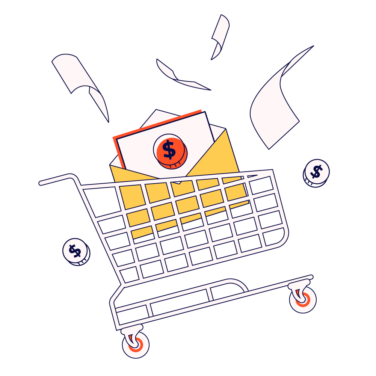With an ever-growing number of competitors, ecommerce businesses have to work hard to attract customers, win their business, and encourage repeat purchases. Thankfully, there are a number of ecommerce CRM strategies that can help you boost sales this year and beyond.
The best ecommerce CRM strategy leverages customer data, product information, ecommerce tools, and marketing research to identify new opportunities and forecast future growth.
In this article, I will go over 12 ecommerce CRM strategies you can use to better connect with customers and boost sales.
1. Go multi-channel
There are so many options for marketing and customer engagement in ecommerce, and it’s beneficial to try out the different tools available to reach your customers. Utilize SMS messaging, email, in-app advertising, push notifications, Facebook ads, on-site overlays, Instagram, and Twitter.
Some tools, like Hootsuite, can help you push on-brand messaging to different social platforms all at once. Others, like Mailchimp, are effective in their niche (email marketing). It will take a complex and multilayered CRM strategy to make sure you speak to your customers where they exist on the web.

You should also pay attention to how messaging works on different channels. Your own landing page and ecommerce store can be pretty flexible when it comes to how information is displayed. Other channels have tighter specifications, though, like Pinterest emphasizing mainly images or Twitter limiting messages to 240 characters.
There’s also no need to touch every possible ecommerce CRM channel. If your customers just don’t care about Instagram, don’t bother setting up an IG Marketplace! Hone in on wherever your customers spend most of their time.
2. Take advantage of automation
While it’s important to treat each customer as an individual, you’ll never be able to personally reach out to each and every customer that buys something from your store or signs up for SMS messages. Marketing automation can help you ensure that no one gets missed.
Most ecommerce sites, like Shopify, WordPress, and Squarespace, have a marketplace of additional apps and plug-ins that you can sift through for automation help. Easy Digital Downloads (EDD), for example, is a plug-in that lets your users download digital products post-purchase so that you don’t have to send the files yourself. This is a very basic example of what automation can do for your CRM strategy.
3. Provide a contextual discount
There is a time and place for discount codes, be careful how you use them. Discounts are best used to lure in potential customers, entice on-the-fence purchasers, alleviate inventory overstock, promote a new product, or re-engage regular customers that have lulled.
On occasion, it’s valid to run site-wide discounts or all-access coupon codes. However, making a deal seem unique or timely is the best way to inspire buyer action. Plus, if you become known for giving away discounts too often, then people will hesitate to pay full price for your merchandise, and you risk devaluing your product.
Contextual discounts can also be a bit of “You scratch my back, and I’ll scratch yours.” For example, many ecommerce businesses give a discount code in exchange for signing up for their mailing list. That way, there’s something in it for everyone. Consider your business processes and experiment with a discount code at checkout to see what your target audience responds to.
4. Aim for a single user identity for each customer
The user identity is how you keep track of customers and record their actions, searches, and purchases. One of the best ways to do this is by having customers sign in to your store. That way, their account is associated with every action they have taken and can provide the best way to keep in contact with them.
It can be hard to convince people to sign up for something new, though. In that case, you can use cookies to identify different IP addresses that visit your store. That way, you can still develop a unique user identity for each customer, even if they are just a casual buyer.
For the richest customer data, consider a membership or club. Users are more likely to sign up and create a customer profile if there is something in it for them. You could offer a “Buy X, get one free” system, or allow them to collect points on purchases and trade them in for discounts or other goodies.
5. Mobile wallet marketing
Most smartphones nowadays have a mobile wallet built-in to the device. If not, there are plenty of mobile wallet apps available to download from third-party sources. Tap-and-pay with phones is becoming more and more popular, with an estimation of 1.31 billion mobile wallet users by 2023. This is the wallet of the future, and as the tech advances, it will certainly become more ubiquitous.
There are already ways to develop digital marketing tools specifically for mobile wallet interfaces. Here, you can gamify shopping experiences, hand out coupons using banner notifications, and even digitize gift cards and vouchers.
Start thinking about mobile wallet marketing now so that you stay ahead of the curve.
6. Prioritize customer experience
If your website or app is difficult to navigate, customers aren’t going to stick around to figure it out, especially if there are easier-to-use options out there. Read customer reviews. If they’re complaining that the site is hard to navigate, take it to heart and fix the problem instead of trying to lure them back with other marketing methods.
You should always be your first customer when it comes to launching a new product or service. Set up a test account and practice browsing, searching, selecting, and buying. If you hit a roadblock anywhere along the way, know that your end-users will too. For some further tips, here are some UX best practices to bear in mind whilst optimizing your site for customer experience. This will naturally enhance metrics like customer loyalty and conversion rates.
7. Invest in a data team
These days, data is king—and you aren’t going to be able to get the most out of your CRM system unless you have a team that knows how to analyze it. Set up a data science team that can segment your data and make sense of it for each department. For example, what questions does your marketing team need to answer when you are looking at customer location data? Or, how can product information data be best visualized for the sales team when they are doing cold outreach?
A dedicated data expert can turn unrelated information into actionable opportunities and insights. They can also help answer questions that different departments might have about customer behavior and how to optimize the sales funnel to best reach a certain demographic.
Is anyone on your team keeping an eye on the latest trends? It's about time someone did!
8. Don’t be spammy, but stay present
No one wants to be spammed with offers, but honestly, this isn’t so much of a problem anymore, at least for emails. Most email clients have a way of sorting promotions into different folders or tabs, which means that, in most cases, your customers don’t see them unless they go looking for them.
What you do need to watch are SMS messages. No one wants to get a text message every day, but you don’t want to wait so long that people don’t remember your brand if they get one. The best thing to do is offer an easy opt-out—for SMS and email—so that people can quickly opt out while others who are still interested maintain contact.
Offer different tiers of correspondence, where relevant. For example, customers might opt into “special deals” communications but opt out of “new product launch” notifications. Let people choose how much they want to hear from you. Learn about your target audience. Draw information from their purchase history. And connect with them to offer personalized email marketing campaigns that speak to their unique interests.
10. Keep an eye on open rates and use them to your advantage
Open rates can be deceiving because the number of people who open an email from you depends solely on the people you send the email to. For example, segmenting address lists by new customers might have a shallower open rate than if you target loyal customers who have given you repeat business. The former is just getting to know you, while the latter is happy to hear from an old friend.
Track the open rates and only re-send emails to people who have opened their last message within the last few weeks. It’s safe to assume that the people who are willingly and regularly opening your emails are engaged with your business. If you target only engaged users with this CRM solution, your open rate will increase.
11. Start a loyalty program.
We talked about giving users to qualified users and using online wallets to organize discounts and loyalty points—the best way to make use of these things is by starting a loyalty program.
Loyalty programs take on many shapes and sizes, so think about what is going to appeal to your customers most and hone in on that.
Here are some examples:
- Points on every purchase that can be redeemed later
- An exclusive, members-only product catalog
- Free shipping to loyalty program members
- Free, no-hassle returns for members, while others pay a restocking fee
- A buy #, get X free digital “punch card” for members only
- An extended product warranty for members only

12. Be there when your customers need you.
It’s safe to say that the biggest thing that customers judge a business on is how they handle complaints. If the customer can’t get a hold of someone, or if they are not satisfied with the way the problem was resolved, they are unlikely to return and will tell everyone about their dissatisfaction.
But, if you handle the complaint well, customer satisfaction increases, and they are likely to come back. Plus, they’ll tell their friends, family, and maybe even their social media followers how happy they are with the way you treat them.
Harvard Business Review carried out a study proving that customer complaints that are handled more quickly (under 5 minutes) can result in the complainer going on to spend more money than they were initially going to. A 5-minute turnaround might be tough, but this goes to show you that a customer complaint handled well can turn things around and become a profitable interaction for your business.

You should always be there for your customer base, and by that, we mean you should actually be present and reachable. Customer relationship management is essential, and nowhere is it more important than when a customer has a complaint.
Consider employing chatbots, an FAQ, an email helpline, a call center, and social media DMs to make sure you are always available for customer interactions. These tools make responsive communication possible for business owners, small businesses, and large organizations alike.
You might also like: Best Ecommerce Customer Service Software
Need expert help selecting the right CRM Software?
If you’re struggling to choose the right software, let us help you. Just share your needs in the form below and you’ll get free access to our dedicated software advisors who match and connect you with the best vendors for your needs.
Make the Most of Your Ecommerce CRM Strategy
The concept of an ecommerce CRM strategy has evolved a lot in recent years. If you can figure out how to take advantage of the data, you can create a tailored customer journey and improve customer retention.
People are more engaged with how they spend their money than ever. With so much information available online, it’s no longer good enough to have a catchy slogan. You need to make sure you’re using every tool at your disposal to create relationships with your customers and keep them coming back for more.
The best CRM tools help your organization optimize user experience, adjust your sales process according to customer behavior, offer targeted functionality within your online store and email marketing campaigns, and provide stellar customer support.
Want to know the best options to implement your strategy? We've curated a list of the best CRM tools for ecommerce.
Keep up to date with all the latest and goings-on in the e-commerce world and receive expert tips and advice by signing up for the ECM newsletter.
More great ECM content:




